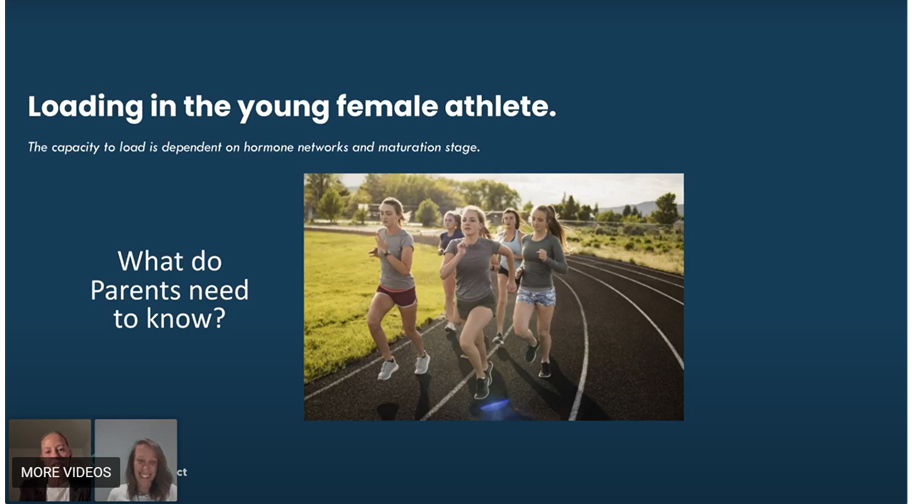Managing the Physical Load of Female Athletes

Giving athletes appropriate physical loads is crucial to helping them optimise their experiences in youth sports. Though a certain level of physical activity is necessary for individuals to develop physiologically and improve their overall performance levels, excessive physical loading can lead to injuries and cause burnout.
In fact, the negative effects of overloading athletes can even negate the benefits accrued through training.
So how can we strike a balance between under- and overworking young people when they play sport?
In this article, we’ll explore the topic of loading in greater detail, paying particular attention to the aspects of physical loading that specifically affect female athletes.
The right type, intensity, and volume of exercise comes down to timing. Different types and levels of physical loading will be appropriate for athletes at different stages of hormonal and physical maturation.
Establishing an Appropriate Physical Load
First and foremost, it’s important to note that the appropriate physical load is different for every athlete. It depends upon a variety of factors, including their biological age, the type(s) of physical activity they’re doing, and the frequency with which they exercise.
Among the most important considerations are their hormone networks and maturation stage. For example, female athletes in the pre-pubescent and early pubic stages have weaker skeletal systems (their bones may be getting longer, but bone density hasn’t really started to develop yet); their bones are in a phase of heightened weakness, so we should carefully manage their exposure to exercises involving jumping and landing, which exert a heavy load on the skeletal system. (Though load-bearing exercises are ordinarily good for building bone strength, their bones may be unable to withstand this much loading at this stage of their development.)
The right type, intensity, and volume of exercise comes down to timing. Different types and levels of physical loading will be appropriate for athletes at different stages of hormonal and
Accounting For Biological Age
When it comes to loading, the biological age of an athlete is more important than their chronological age.
Take the example of two 14-year-old girls, where one hasn’t started menstruating and the other has been cycling for 18 months; the latter will have had 18 additional months of producing oestrogen, increasing their bone mineral density, and developing their endocrine system — and therefore (probably) be able to handle larger impact loads.
Likewise, a girl who has not reached the stage of producing larger volumes of important sex hormones (oestrogen and progesterone) will likely have a less robust skeletal system. Consequently, she might frequently complain of small aches and pains — perhaps an ankle one day, a knee the next — because her body does not tolerate the same levels of loading as those of her peers.
This is not a cause for worry, but for adaptation; in such instances, we can help less-developed children by encouraging them to play many different sports (rather than experiencing heightened repetition of the same activities and movement patterns).
Recovery is arguably the most important part of any child’s sporting programme. This is when the hormones do their best work — exerting their biggest impact (repairing and re-building better) on the body while children are sleeping and resting. If female athletes are not given adequate opportunities to recover, crucial hormone networks can be negatively affected, potentially resulting in the downregulation of vital functions such as the menstrual cycle. Furthermore, athletes only benefit from training when they are able to sufficiently recover.
The key benefits from recovery are:
- Enhanced performance: gains will occur because athletes’ hormones are working and driving the adaptation to training.
- Protection against injury and illness: under-recovery leads to unbalanced health, and unbalanced health is one of the biggest causes of injury and illness.
- Improved mental wellness: athletes are likely to experience better moods, feel more motivated to train, and subsequently be more capable of learning.
Given the value of effective recovery, it’s often recommended that young people have at least one day without strenuous physical activity each week.
Encouraging Appropriate Recovery Opportunities
What constitutes a good rest day for athletes depends upon the individual. But, generally speaking, it’s recommended that younger athletes take a complete day without considerable physical exertion. We should also endeavour to recognise what recovery looks like for our children; for example, teenagers may sometimes be portrayed as lazy, but if their lives are balanced — if they’re training and then recovering — then what seems like ‘lying around’ might actually be a crucial phase of recovery.
When athletes are older — and their musculoskeletal and hormonal systems are more developed — rest days can be more active, potentially including light training. However, recovery should be periodised throughout the season, so that rest periods are increased when the intensity and frequency of physical loads (such as those attributed to competition) are at their highest.
For parents, the challenge is always to know when young athletes should pull back. Crucially, when we see signs of unbalanced health, we must encourage athletes to proactively take rest and recover.
Supporting Balanced Health in Female Athletes
Helping young people maintain balanced health is key to supporting their involvement in sport. Here, we consider five key areas related to the overall health of female athletes:
- Menstruation: regularly check-in with your children about their menstrual cycle, and know how to identify when a cycle is healthy.
- Nutrition: be attentive to young females showing signs of disordered eating practices (such as skipping particular food groups or only using food as a reward) or developing body image issues and seek help if you have any concerns. Where possible, send food with them, to ensure they fuel adequately to maintain energy.
- Sleep: young athletes need 8+ hours of sleep per night to reduce the risk of injury and illness. Sometimes, it may be more effective to encourage sleep for health and performance benefits, rather than for parental reasons.
- Injury and illness: be alert if your child experiences multiple repeating illnesses, as this is often a sign of overload which causes their immune system to be suppressed. Given that females are at greater risk of bone-mineral-density issues and bone injuries such as shin splints and stress fractures, bone health should also be a major focus for all female athletes. If your child is experiencing unexplained pains, or pain that doesn’t subside and still hurts when they rest, it might be necessary to see a doctor or physiotherapist.
- Training and motivation: keep track of your child’s motivation to attend training, and their overall mood concerning their sport. This will help you to notice signs of fatigue and psychological burnout. It is important that they have time for hobbies, relaxation and social connection beyond sport.
Ultimately, the key to managing the physical load of athletes is monitoring them for signs of being overworked, and ensuring that they take adequate breaks. Appropriate physical loading is a balancing act, but it’s something we all must strive for — for the longer-term development and health of female athletes.
In Summary
- Giving athletes appropriate physical loads is key to optimising their long-term development, health, and enjoyment of sport.
- Physical load is determined by the type, intensity, and volume of an exercise.
- The appropriate load for an individual will depend upon factors like their hormonal development and maturation stage.
- Teenage girls are especially vulnerable to musculoskeletal injuries. We should be careful not to over-expose them to exercises that place large physical loads on the bones.
- Adequate recovery is essential to attaining the benefits of training and safeguarding health.
- As parents, we must observe our children for signs of overexertion, and ensure that they take breaks from sport where necessary.
Image Source: Stefano Oppo from corelens








































